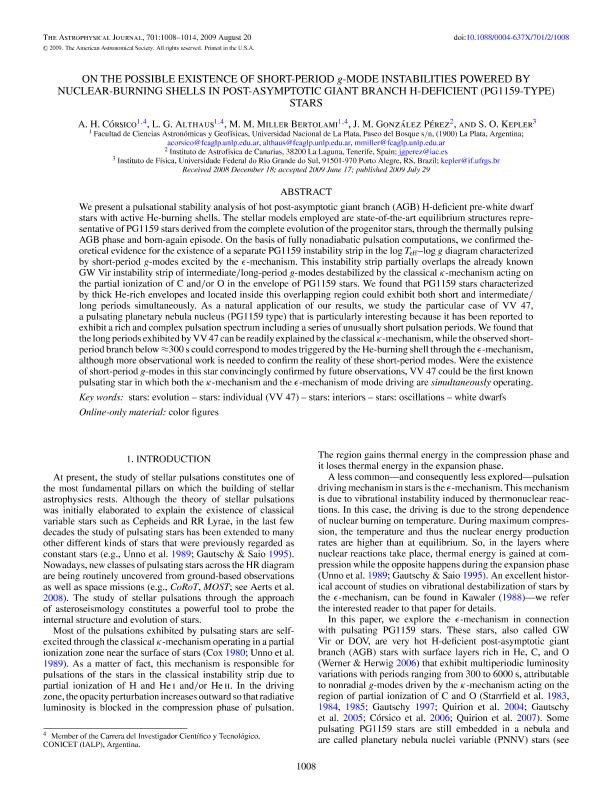Mostrar el registro sencillo del ítem
dc.contributor.author
Corsico, Alejandro Hugo

dc.contributor.author
Althaus, Leandro Gabriel

dc.contributor.author
Miller Bertolami, Marcelo Miguel

dc.contributor.author
González Pérez, J. M.
dc.contributor.author
Kepler, S. O.

dc.date.available
2018-04-23T13:41:54Z
dc.date.issued
2009-08
dc.identifier.citation
Corsico, Alejandro Hugo; Althaus, Leandro Gabriel; Miller Bertolami, Marcelo Miguel; González Pérez, J. M.; Kepler, S. O.; On the possible existence of short-period g-mode instabilities powered by nuclear-burning shells in post-asymptotic giant branch H-deficient (PG1159-type) stars; IOP Publishing; Astrophysical Journal; 701; 2; 8-2009; 1008-1014
dc.identifier.issn
0004-637X
dc.identifier.uri
http://hdl.handle.net/11336/42985
dc.description.abstract
We present a pulsational stability analysis of hot post-asymptotic giant branch (AGB) H-deficient pre-white dwarf stars with active He-burning shells. The stellar models employed are state-of-the-art equilibrium structures representative of PG1159 stars derived from the complete evolution of the progenitor stars, through the thermally pulsing AGB phase and born-again episode. On the basis of fully nonadiabatic pulsation computations, we confirmed theoretical evidence for the existence of a separate PG1159 instability strip in the log T <sub>eff</sub>-log g diagram characterized by short-period g-modes excited by the epsilon-mechanism. This instability strip partially overlaps the already known GW Vir instability strip of intermediate/long-period g-modes destabilized by the classical κ-mechanism acting on the partial ionization of C and/or O in the envelope of PG1159 stars. We found that PG1159 stars characterized by thick He-rich envelopes and located inside this overlapping region could exhibit both short and intermediate/long periods simultaneously. As a natural application of our results, we study the particular case of VV 47, a pulsating planetary nebula nucleus (PG1159 type) that is particularly interesting because it has been reported to exhibit a rich and complex pulsation spectrum including a series of unusually short pulsation periods. We found that the long periods exhibited by VV 47 can be readily explained by the classical κ-mechanism, while the observed short-period branch below ≈300 s could correspond to modes triggered by the He-burning shell through the epsilon-mechanism, although more observational work is needed to confirm the reality of these short-period modes. Were the existence of short-period g-modes in this star convincingly confirmed by future observations, VV 47 could be the first known pulsating star in which both the κ-mechanism and the epsilon-mechanism of mode driving are simultaneously operating.
dc.format
application/pdf
dc.language.iso
eng
dc.publisher
IOP Publishing

dc.rights
info:eu-repo/semantics/openAccess
dc.rights.uri
https://creativecommons.org/licenses/by-nc-sa/2.5/ar/
dc.subject
Evolution of Stars
dc.subject
W 47 (Estrella)
dc.subject
Interior Stars
dc.subject
Oscillations
dc.subject
White Dwarfs
dc.subject.classification
Astronomía

dc.subject.classification
Ciencias Físicas

dc.subject.classification
CIENCIAS NATURALES Y EXACTAS

dc.title
On the possible existence of short-period g-mode instabilities powered by nuclear-burning shells in post-asymptotic giant branch H-deficient (PG1159-type) stars
dc.type
info:eu-repo/semantics/article
dc.type
info:ar-repo/semantics/artículo
dc.type
info:eu-repo/semantics/publishedVersion
dc.date.updated
2018-04-19T18:32:50Z
dc.journal.volume
701
dc.journal.number
2
dc.journal.pagination
1008-1014
dc.journal.pais
Estados Unidos

dc.description.fil
Fil: Corsico, Alejandro Hugo. Consejo Nacional de Investigaciones Científicas y Técnicas. Centro Científico Tecnológico Conicet - La Plata. Instituto de Astrofísica La Plata. Universidad Nacional de La Plata. Facultad de Ciencias Astronómicas y Geofísicas. Instituto de Astrofísica La Plata; Argentina. Universidad Nacional de La Plata. Facultad de Ciencias Astronómicas y Geofísicas; Argentina
dc.description.fil
Fil: Althaus, Leandro Gabriel. Consejo Nacional de Investigaciones Científicas y Técnicas. Centro Científico Tecnológico Conicet - La Plata. Instituto de Astrofísica La Plata. Universidad Nacional de La Plata. Facultad de Ciencias Astronómicas y Geofísicas. Instituto de Astrofísica La Plata; Argentina. Universidad Nacional de La Plata. Facultad de Ciencias Astronómicas y Geofísicas; Argentina
dc.description.fil
Fil: Miller Bertolami, Marcelo Miguel. Consejo Nacional de Investigaciones Científicas y Técnicas. Centro Científico Tecnológico Conicet - La Plata. Instituto de Astrofísica La Plata. Universidad Nacional de La Plata. Facultad de Ciencias Astronómicas y Geofísicas. Instituto de Astrofísica La Plata; Argentina. Universidad Nacional de La Plata. Facultad de Ciencias Astronómicas y Geofísicas; Argentina
dc.description.fil
Fil: González Pérez, J. M.. Instituto de Astrofísica de Canarias; España
dc.description.fil
Fil: Kepler, S. O.. Universidade Federal do Rio Grande do Sul; Brasil
dc.journal.title
Astrophysical Journal

dc.relation.alternativeid
info:eu-repo/semantics/altIdentifier/doi/http://dx.doi.org/10.1088/0004-637X/701/2/1008
dc.relation.alternativeid
info:eu-repo/semantics/altIdentifier/url/http://iopscience.iop.org/article/10.1088/0004-637X/701/2/1008/meta
Archivos asociados
